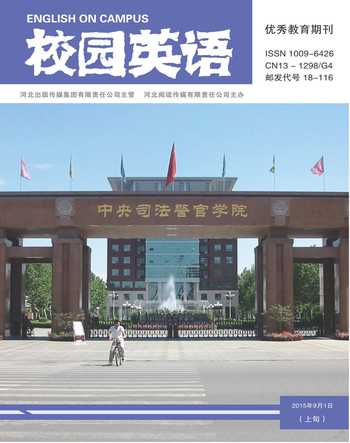An analysis of mind style in the short fiction Chrysanthemums
赵海燕
【Abstract】The paper selected John Steinbecks short fiction The Chrysanthemums and focused on the analysis of Steinbeck and Elisa mind style.It is hoped that the present research will provide a new perspective for reader s and critics in appreciating and analyzing characters in short fiction.
【Key words】mind style; Chrysanthemums; characters in fiction
1.Introduction
In this paper,the author applied the “mind style” theory to analyze two people's mind style in The Chrysanthemums:Steinbeck and Elisa.And the author used the multilevel approach to analyze those characters mind style.But this paper not only aims to analyze the mind style of character,but also aims to extend the studies of mind style to a wider application.
2.Mind style
A mind style refers to the way in which consistent linguistic patterns in a text can create a particular world-view,a characteristic way of perceiving,understanding and conceptualizing the textual “world”.Fowler (1996) definitely presents the notion of “mind style” as equivalent to those of “world view” and “point of view on the ideological plane”:
Fowler definition of mind style includes two aspects:(1).World views that are social,cultural,religious or political in origin.(2).World views that are primarily personal and cognitive in origin.
3.A brief introduction to The Chrysanthemums
The Chrysanthemums is a short fiction in which Henry was a farmer who usually concerned with his business and ignored his wife.And Henrys wife was Elisa Allen felt lonely,so she planted many chrysanthemums in her garden and took care of them very carefully.One day she met a tinker and gave him the chrysanthemums in the hope of that he can take it.But the tinker threw away the chrysanthemums.At that time she cried...At the end of the story,John Steinbeck just used a sentence She turned up her coat collar so he could not see that she was crying weakly---like an old woman.
Although it is a very short story,but John Steinbeck used many different adjectives in the short fiction.Thus it can be a vivid short story.
4.Analysis of the mind style in The Chrysanthemums
Analysis of Elisas mind style
In The Chrysanthemums,Elisas mind style is different from others.She keeps a positive attitude towards her life.Let us look at those adjectives one by one.We have got the result of the investigation shown in the following examples:
Example1:Her face is eager and mature and handsome; even her work with the scissors was over-eager,over-powerful.
Here the words “eager,mature,handsome” can tell us that Elisa usually has an eager expression which means she is eager to do something.
Example 2:Behind her stood the neat white farm house...It was a hard-swept looking little house with hard-polish windows,and a clean mud-mat on the front steps.
From the words “neat,white,hard-swept,hard-polished”,we know Elisa was positive for her life.Although the people around her cannot understand her.
Example 3:“Yes.Theyll be strong this coming year.”
Here “strong” refers to the chrysanthemums,but actually,from her tone,we can know that “strong” implies she hoped that her life will be as “strong” as the chrysanthemums in “this coming year”.Thus we can say that she keeps a positive attitude towards her future life.
Example 4:“Elisas eyes grew alert and eager.”
When Elisa knew that the tinker was interested in her followers,she felt happy.Although she was alert,she was eager to introduce her followers to the stranger.
5.Conclusion
The present paper has focused on analysis of both the writer and the characters mind style.Such studies can reveal not only the style of a writer,but also his habitual way of interpreting the world.It is possible to conduct this kind of research by examining the systematic linguistic patterns in the literary works.It is hoped that the present research can stimulate further studies of mind styles,especially by taking a multilevel approach to text analysis.
References:
[1]Carter,R.and Paul,S.Language,Discourse and Literature.London:Unwin Hyman,1989.
[2]Fowler,R.Linguistic Criticism.Oxford:Oxford University Press,1996.

